The Pacific Plaza Towers is one of those cozy upscale condominiums in BGC. There are only four units per floor, and each unit is several hundreds of square meters big. Unlike many other condos, the twin towers stand unmarred by a developer. While originally developed by MVP, the residence is now collectively owned by the homeowners association. It’s a nice little setup that gives power to the residents to decide on what goes on in their home, a luxury that not many other condo dwellers have.
I think this as I stand a block away from the towers. Near me, a white convertible slows down, the foreigner driving it careening his neck to see the commotion from across the street. Which made sense—what was playing out was a scene out of step with the poshness of the area.
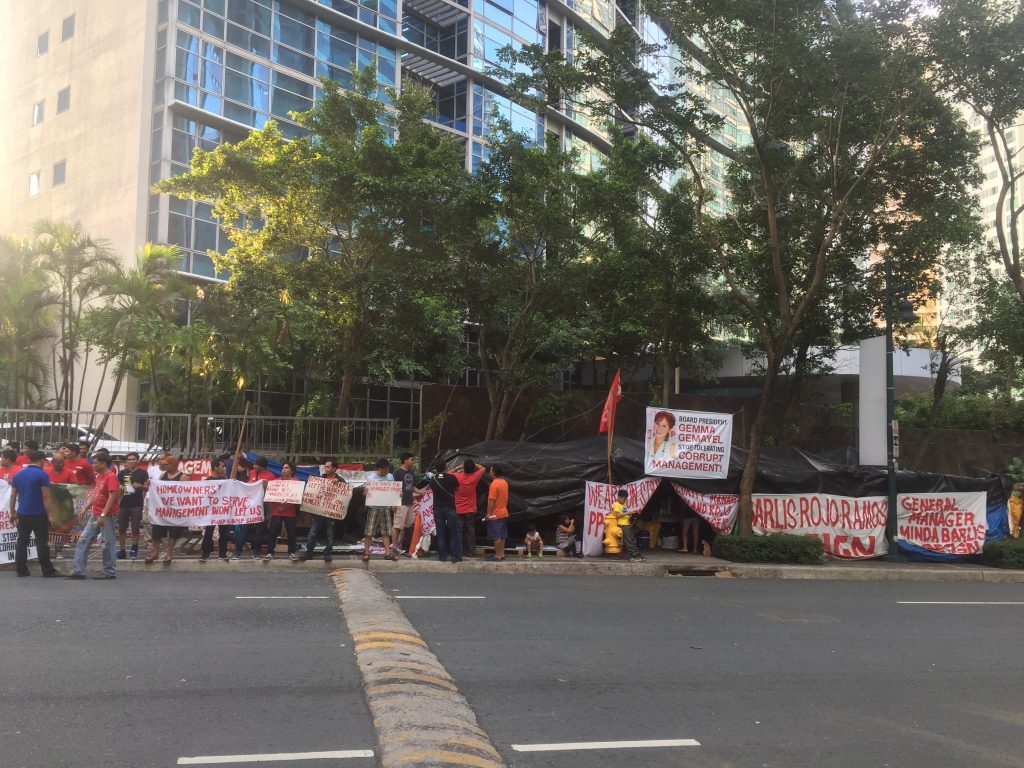
Grazing the entrance of the tower is a large tent decorated with posters and picket signs. Gathering outside it is a group of people carrying their own posters and pickets, similar to the tent’s. One person speaks into a bullhorn that rings loud enough, or so I’m told, that the Pacific Plaza residents are able to hear them from inside the tower.
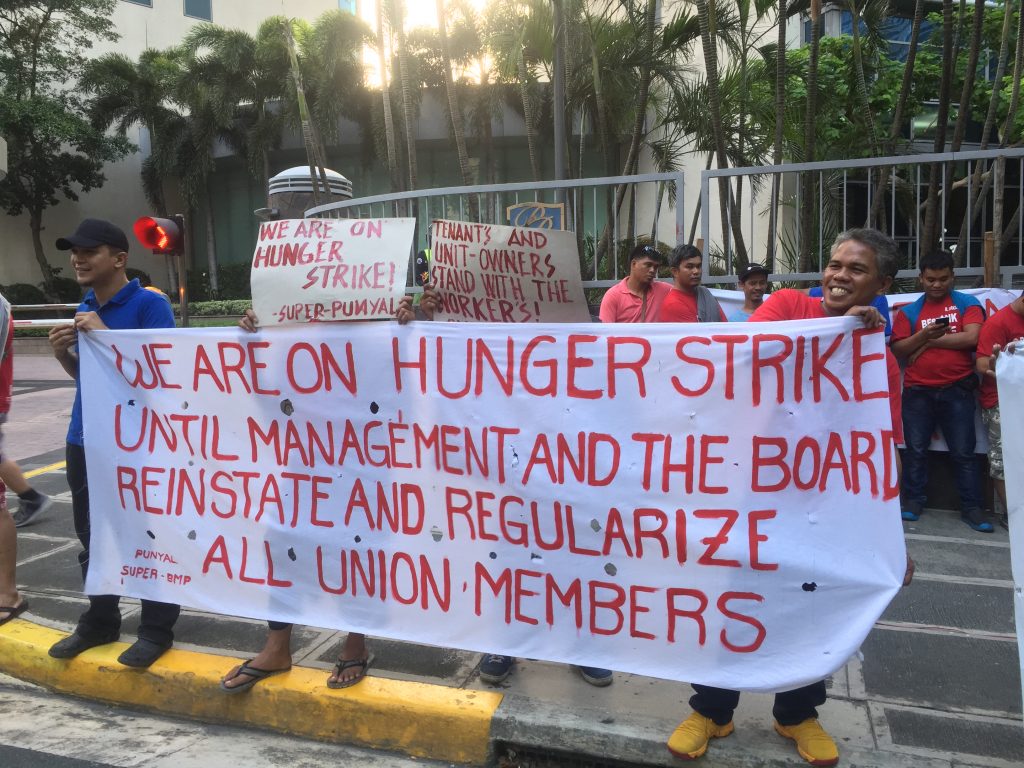
For the past two months, the union workers (electricians, custodians, aircon specialists, etc) of Pacific Plaza have been living in that tent, accompanied by some activists and other union groups, holding a union strike certified by the DOLE. Every week, they hold a mobilization to rally up the people for their cause. The day I visit, Oct. 7, the mobilization was especially charged. It had been two days since they, fed up with their demands being ignored, started their hunger strike.
False promises and a union dispute
On the car ride going there, a Bukluran ng Manggagawang Pilipino organizer briefs me on the strike. “There are a lot of dimensions to this,” he says, looking through his rearview mirror. The easiest one to figure out is that entire thing all started because of a union dispute.
The current union holding the strike, PUNYAL, isn’t the first union organized by the Pacific Plaza workers. Back in 2015, the workers started a union so they can gain more benefits and have the contractual workers turned regular. The management acquiesced, but with a caveat: the workers will be given all that as long as they dissolved the union. The workers, thinking that all was right, did so. The management went on to make the union leaders (except the president and the board chairman, which they fired) into supervisors. It was a symbolic gesture; though the workers were named supervisors, their duties did not change.
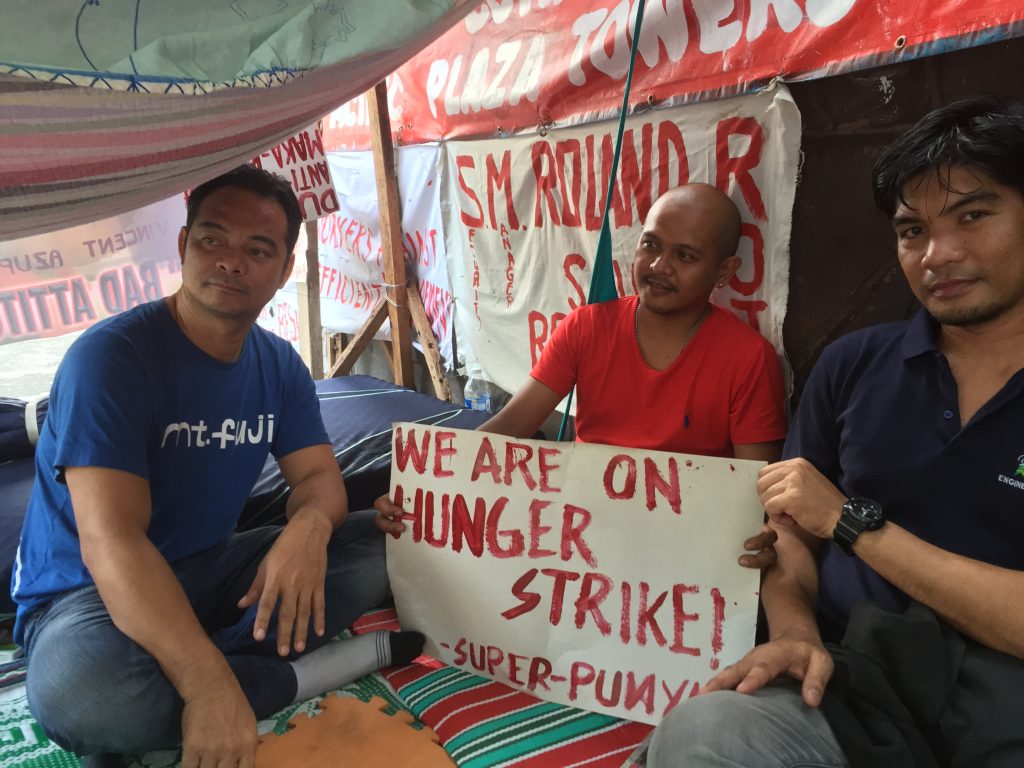
“That was a strategic move,” the president of PUNYAL, Cris Katane Rafales, tells me. A regular worker, he has (or rather, had) been working with Pacific Plaza for 12 years. “When you’re a supervisor, you’re formally part of the management. You can no longer join a union.” When he says this to me, we are inside their tent, a long makeshift abode made of tarpaulin and wood. I am told that the tent was strong enough that it outlasted a storm. When I had entered there, I caught a few men making a poster to use for the picket line.
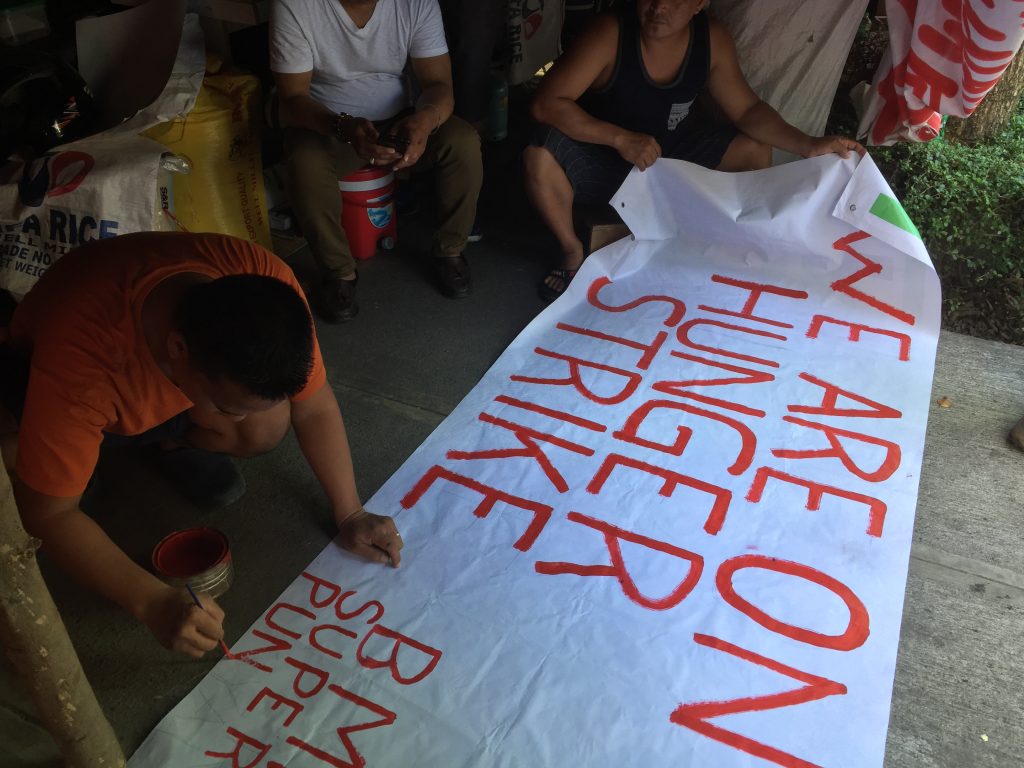
“PUNYAL,” one of the men started to write. It stands for Pacific Plaza United Action of Labor, the union set up this year by the workers. Three years after the dissolution of the first union, the management have still never given the workers what they had promised them. “Ni-isa, wala silang nabigay,” union member Abdul Tambalungan says. Instead, the management held a tighter grip on the workers, forcing security guards to monitor them at all times and to accompany them to their jobs, which often was a hassle for both the workers and the security personnel.
“Hindi na namin matiis,” Ka Abdul confides. “Ako talaga ang nagpursige na makabuo kami ng union.” Ka Abdul is the oldest of the union members at 58. He had been working at Pacific Plaza for over twenty years, and had become a supervisor. When the strike started, he was two years away from retirement.
What really spurred them on, however, was the contractual workers finding out that Pacific Plaza was firing PolyStar, the agency to which they were under contract.
A quick refresher on labor: Labor-only contracting is the illegal form of contractualization. In a labor-only scheme, there is a principal business, the workers, and the agency. The agency gets the worker and deploys them to the principal business, and that’s all they do. It essentially only provides labor. All the tools used by the workers are owned by the principal business. Their supervisors are also from the principal business. They do the same work as the regular employees of the principal business. Basically, they do direct work under the principal business, but are “hired” by the agency. The relationship between Pacific Plaza and PolyStar ticks all these boxes.
What makes labor-only contracting so bad? The agency prevents the workers from having security of tenure from their actual workplace. They can’t fight for higher wages, they have no say. And if the principal business does away with the agency, the workers are also left by the wayside. When the contractual workers found out about Pacific Plaza’s plans, they knew time was running out.

Soon after PUNYAL was formed, the union was able to request a labor inspection from DOLE. The Pacific Plaza management had been violating many other labor rules. Some of which include: non-remittance of their SS, Pag-ibig, and Philhealth; delayed salaries with undisclosed deductions; and salary deductions towards a shady health card from a little-known company, of which no health remuneration have been given to the workers.
On Jun. 8, DOLE sent out their labor inspector to check out PUNYAL’s claims. She was not able to that day; the management had barred her from doing so, threatening legal action if she did her job. Eventually, she was escorted out of the building.
The morning of the aborted labor inspection, the management gathered their 17 contractual employees (some of whom had been working for the company for upwards of four years). The management told them to clean out their lockers, and had every single one of them inspected lest they were carrying stolen objects. When the management was satisfied, the workers were summarily dismissed. “They treated us like criminals. Even our wallets were inspected,” another worker, Judy Pastorperde, told me.
After the workers were laid off, the management allowed the inspector to come back in.
The first strike in BGC
“You illegally arrested us, chained us in handcuffs,” I hear one of the speakers blaring over the megaphone.
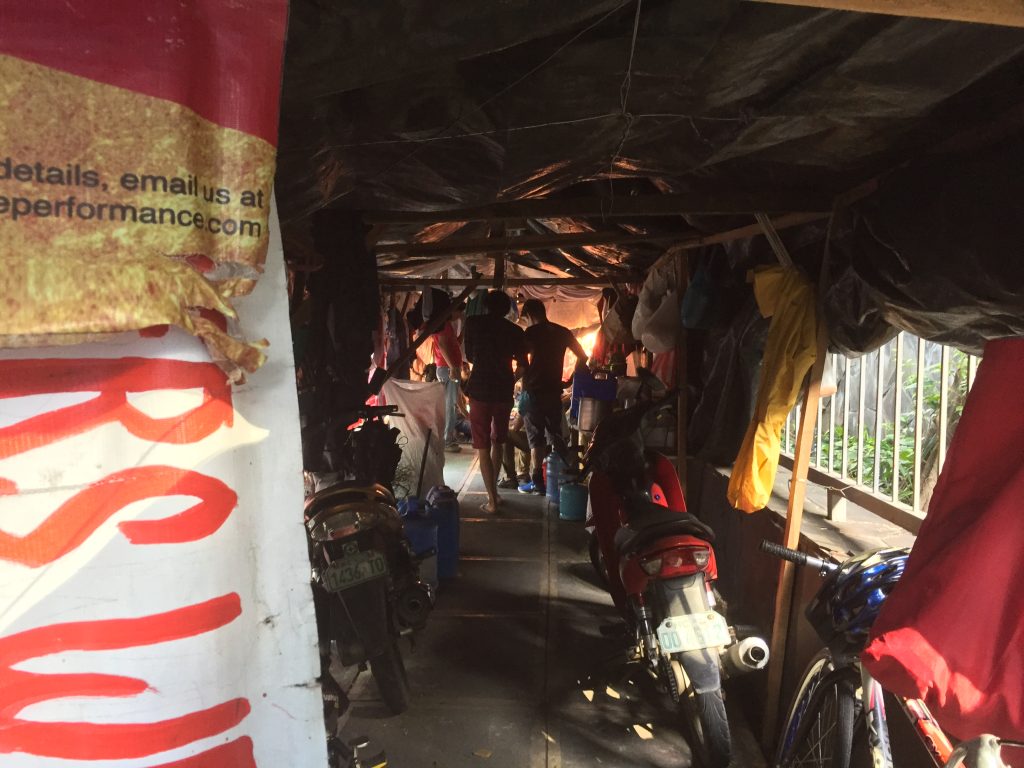
“After the workers were fired, that’s when we decided to file a notice of strike,” the BMP organizer who drove me had said. “In case you don’t know, when you’re going to do a strike, you can’t just suddenly go out.” There’s a legal process to a strike, I soon found out, and the day PUNYAL’s strike commenced, they had the legal say-so from DOLE.
But before the strike started, the union still tried to talk to the management. Ka Abdul narrates the scene to me. “‘Ano ba ang gusto niyo,’ sinabi ng management. ‘Ibalik yung 17 na contractual.’ Ano ang sabi nila? Sabi nila, kahit kailan, hindi namin balikan ang contractual bagkus kahit kayong mga regular, tatanggalin din namin.'”
“The management is very hardline,” my friend, the BMP driver, had explained earlier. “They maintain that the contractual workers are not their employees but the agency’s, and so wala silang panagutan sa kanila.”
“Huling hirit namin,” Ka Abdul continues, “kung ganoon Ma’am, bigyan niyo kami ng pambili ng kendi at aalis kami ng building ng matiwasay. Pambili lang ng kendi para ang mga anak namin may pabaon. Kasi kung masusunod yung gusto niyo, hindi na kami papasok bukas.”
The management’s reply? “Wala kayong makukuha.”
That was two days before the strike.
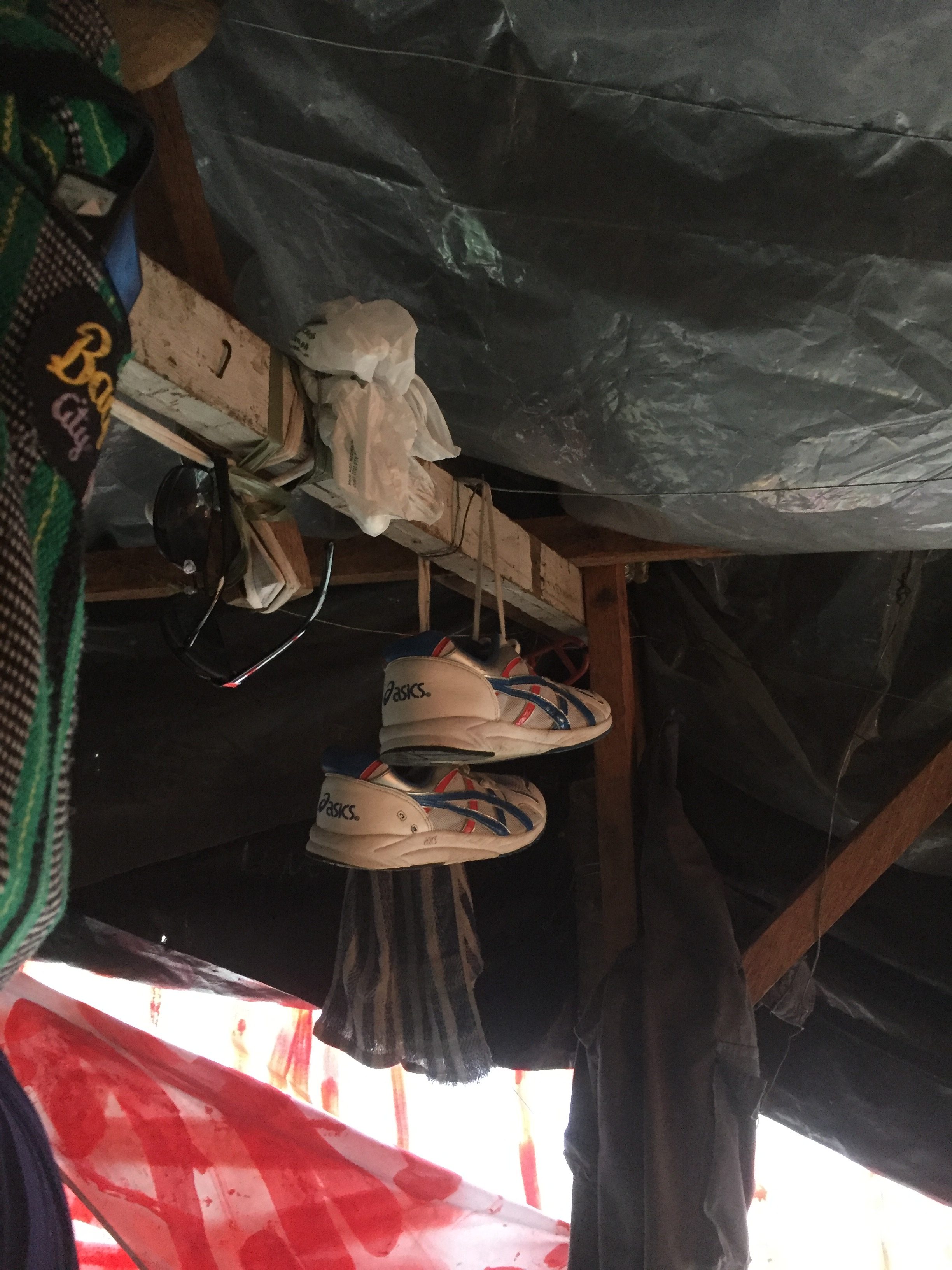
A fact that has evaded some people is that the Pacific Plaza strike is the first strike to take place in BGC. This might’ve had a hand in how the police responded on Aug. 6, the first day of the strike. The workers and BMP members had set up their kubol (the name they call their tent) and were peacefully protesting. However, the Taguig police stepped in. “Marami sa amin ang naposasan,” Ka Abdul says. The police, who had been contacted by the Pacific Plaza management, arrested the protesters and brought to the precinct.
This is illegal, my friend had pointed out. The police are not allowed to just arrest people on strike. “The only body that has a right to say that your strike is illegal is DOLE. Until DOLE deems it illegal, the police have to stay 50 meters away.” Maybe the police didn’t know that. Maybe they did. Either ways, the protesters were not intimidated. They came back to their tent shortly after, this time with a letter from Secretary Bello himself approving the strike.
“We’ve been on the picket line for two months. At the beginning, we got donations. There have been some homeowners who’ve reached out. The problem is that most of them don’t really care. Or they do, and they feel bad for the workers, but they don’t care enough to do anything. The management is hardline. The board president is also hardline. They need to pressure the board into terminating the management and reinstating and regularizing the workers.”

What has the management been saying about the strike?
For starters, the workers have been painted as criminals. “They’ve been spreading rumors that they’ve sabotaged the water systems. We’ve asked for evidence from their CCTVs, but nothing.” The management later claimed that found missing tools in the workers’ lockers, pointing to that as evidence of both theft and the sabotage. However, as my friend pointed out, the workers had already left to go on their strike when that was found out. “Malamang the management planted the items in the lockers.”
“They’re also trying to get our strike declared illegal, justifying that because the strike is blocking people from going in and out, it’s illegal. They’re saying we’re endangering the children because the children have to pass by the picket line,” my friend added. The tent is just on the sidewalk, near the entrance but not in any way obstructing it.
The management have filed a temporary restraining order against the union.
The BMP is also helping the workers file a case against the management. “When we said that the workers were illegally terminated, Pacific Plaza fought back by saying, ‘No, they were not terminated, it’s just that our service agreement ended in July.’ But we have a lot of evidence that shows that they had no service agreement. they made a fake service agreement that says it ended in July. What’s our evidence? Look at the worker’s IDs. It says the service agreement expires in December, not July. We went to DOLE, because if you have a service agreement, you file it with them. DOLE told us that there was no service agreement on file. And actually, in the list of clients of PolyStar circa 2016, Pacific Plaza isn’t there. It’s one of those informal agreements.”
The problem with legal cases is that they take five to six years to process with the Supreme Court, however. “By that time, gutom na yung workers, he said. “Without doing something drastic, nothing will happen.”
Something drastic
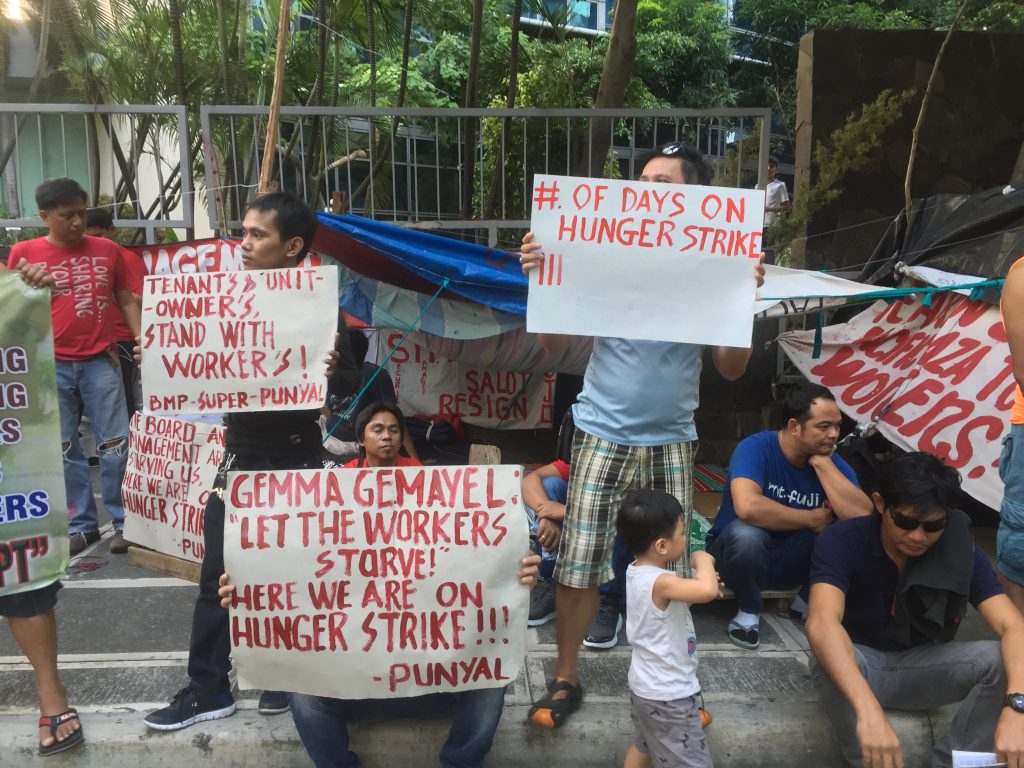
Quick question: how well do you know your hunger strikes? For a lot of people, hunger strikes bring to mind Gandhi or Ninoy Aquino, but not much else. I took a class on non-violent protests in college, but even then, the example that readily comes to mind is Aquino, frail and thin at the end of his 40-day hunger strike.
Hunger strikes are one of the strongest nonviolent acts, and also one of the most dangerous. They’re essentially fasts until death; after the third day, the body starts processing its own internal fat. Eventually, the body goes on starvation mode, and this can lead (and has led) to death. The protester on a hunger strike is pressuring the governing body to meet his or her demands, or else his or her blood is on their hands. It’s not something to take lightly.
Sometime over the course of the strike, the board president of the homeowner’s association was asked to weigh in on the matter. “Hayaan niyo silang magutom,” was her callous response. When the union and BMP members were deciding what their next move was, they came back to that line. They decided to take her on, but on their own terms.
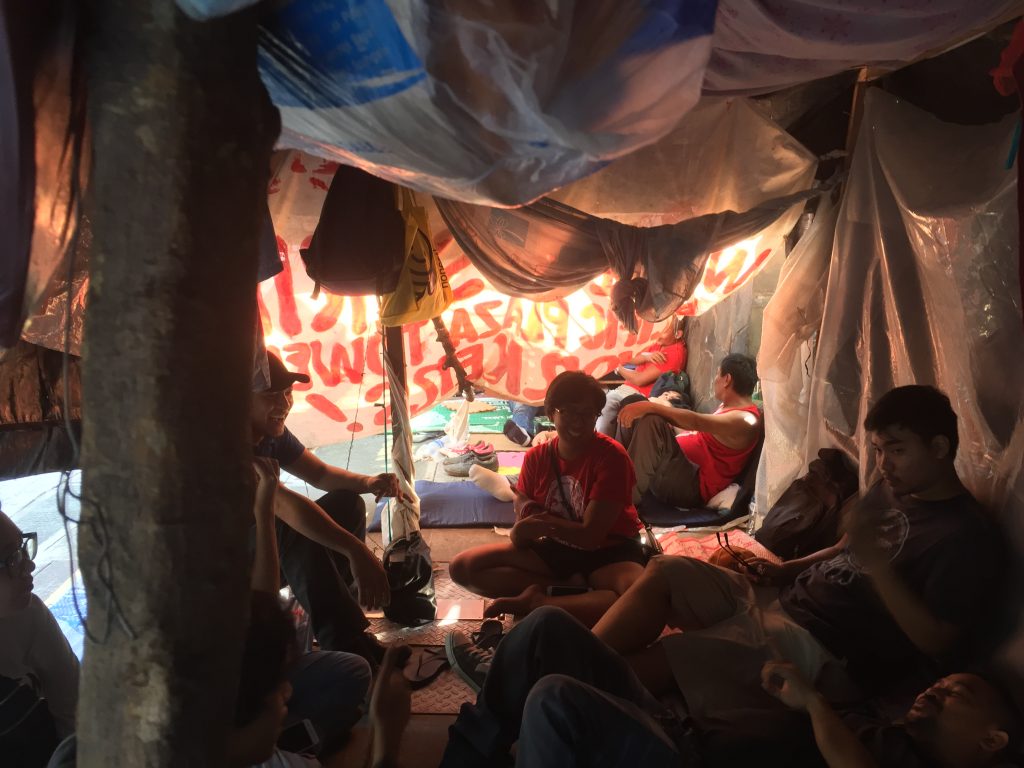
Only four workers (two regular, two contractual) went on a hunger strike on Oct. 5. When I visited the picket line three days later, they had been jovial about it still, chiding one of the workers for starving and yet not losing weight. But they did not forget the risks: one of the workers on hunger strike was Ka Abdul. Though far from frail, Adbul is 58 and has blood pressure problems, like most men his age. Nobody says it in the tent, when everyone is joking and families are joining together in conversation; only outside, when a mass demonstration starts: these people, who have already put themselves and their families at risk for their cause, are prepared to die.
On Friday, Oct. 19, it would mark two weeks since the start of the strike. The four workers have increased to sixteen, with more soon to follow.
Do we wait for blood to be shed for something to be done? I don’t live anywhere near the Pacific Plaza Towers, and yet I feel responsible, in some way, for their struggle. People shouldn’t have to resort to a hunger strike to be heard, especially in this day and age. To see these workers and their families slowly dying of hunger and to go on with your life, casually and freely, paying them no heed save for a few “poor yous,” that takes some special kind of cognitive dissonance or moral paralysis. Something like that.
The sad thing is, that’s what I expect. Our culture has grown so numb that I’m not sure if all this pain and suffering really registers in people’s minds anymore. I am cautiously optimistic for the workers, but I remain skeptical of everyone else.
Prove me wrong, Pacific Plaza residents. Do something. With all that power, you could save a life.
Update as of Tuesday, Oct. 23: The management finally relented to starting negotiations, but requested for the workers to tear down their picket line as an act of “good faith.” Rather than completely ending their strike, the workers have decided to end their hunger strike and take down some of their signs as they wait for the management’s offer. The tent still remains.
This is an ongoing story.
Get more stories like this by subscribing to our newsletter here.
Read more:
Anti-Marcos student protester is one of 2017’s most influential teens
These haunting images of the protests in Venezuela will give you the shivers
LOOK: Netizens react to Jollibee’s Ateneo Art Gallery visit
Read more by Zofiya Acosta:
Women should be able to use contraceptives without fear of abuse
Universities should do more to protect their students
FYI, Boracay isn’t your personal dumping ground












































